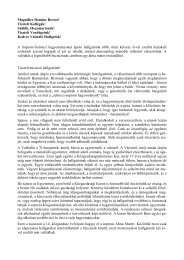Floral Nectar Production and Nectar Sugar Composition of ...
Floral Nectar Production and Nectar Sugar Composition of ...
Floral Nectar Production and Nectar Sugar Composition of ...
Create successful ePaper yourself
Turn your PDF publications into a flip-book with our unique Google optimized e-Paper software.
International Scientific Conference March 26-27 2012<br />
on Sustainable Development & Ecological Footprint Sopron, Hungary<br />
<strong>Sugar</strong> concentration was measured with a h<strong>and</strong> refractometer (ATAGO N-50E). <strong>Sugar</strong> value<br />
was calculated using the formula: nectar volume (µl) * nectar concentration (%)/100.<br />
2.4.2. <strong>Nectar</strong> sugar composition<br />
Dried nectar samples were taken up in 70% (v/v) ethanol. <strong>Sugar</strong> st<strong>and</strong>ards (sucrose, glucose,<br />
fructose; 1 mg/ml each) <strong>and</strong> nectar samples were applied to plates (Silica gel 60 F254, Merck)<br />
by microcaps. Plates were run twice in developing chambers without saturation. The mobile<br />
phase consisted <strong>of</strong> ethyl acetate : ethanol : 60% acetic acid : water coldly saturated with boric<br />
acid (50:20:10:10). Spots were visualised by dipping plates into a thymol-sulphuric acid<br />
reagent for 3 sec, then dried at room temperature, <strong>and</strong> finally at 105°C for 5 min.<br />
Densitometric evaluation was performed by a CAMAG TLC Scanner at 510 nm, using the<br />
s<strong>of</strong>tware CATS 3.14 for quantitative measurements.<br />
3. RESULTS<br />
3.1. Structural features <strong>of</strong> the nectary<br />
The floral nectary <strong>of</strong> cotoneasters is automorphic <strong>and</strong> receptacular, positioned between<br />
the ovary <strong>and</strong> the base <strong>of</strong> the stamens (Figure 1). The cuticle covering the nectary surface has<br />
an irregular ornamentation consisting <strong>of</strong> wrinkles <strong>and</strong> creases (Figure 2).<br />
stamen<br />
nectary<br />
Figure 1. <strong>Nectar</strong>y <strong>of</strong> Cotoneaster lancasteri<br />
<strong>Nectar</strong> is secreted through stomata, whose guard cells are either in level with the epidermal<br />
cells or slightly below the level <strong>of</strong> the epidermis (Figure 3). Subepidermally, 3 to 4 layers <strong>of</strong><br />
small, isodiametric cells comprise the gl<strong>and</strong>ular tissue; followed by the larger cells <strong>of</strong> nectary<br />
parenchyma (Figure 4). Calcium oxalate druses frequently occur in the parenchymatous<br />
tissues <strong>of</strong> both the gl<strong>and</strong> <strong>and</strong> the receptacle. Directly beneath the nectary parenchyma vascular<br />
bundles can be observed.<br />
nectary stomata<br />
style<br />
ovary<br />
Figure 3. <strong>Nectar</strong>y stomata <strong>of</strong> C. hissaricus<br />
3<br />
Figure 2. <strong>Nectar</strong>y surface <strong>of</strong> C. kitaibelii<br />
epidermis<br />
gl<strong>and</strong>ular<br />
tissue<br />
nectary<br />
parenchyma<br />
Figure 4. <strong>Nectar</strong>y structure <strong>of</strong> C. glomerulata





